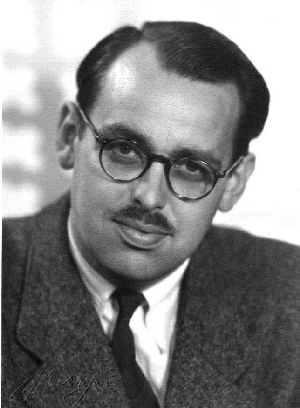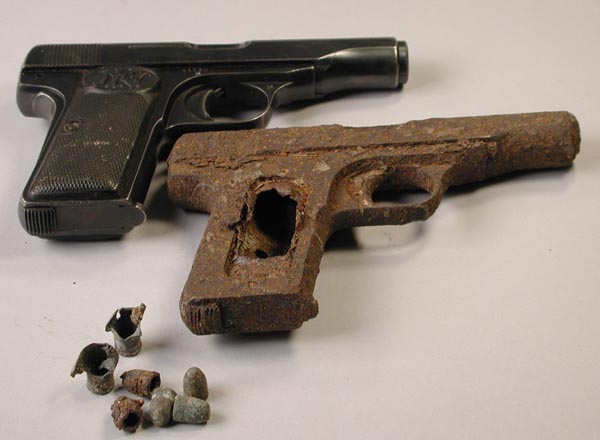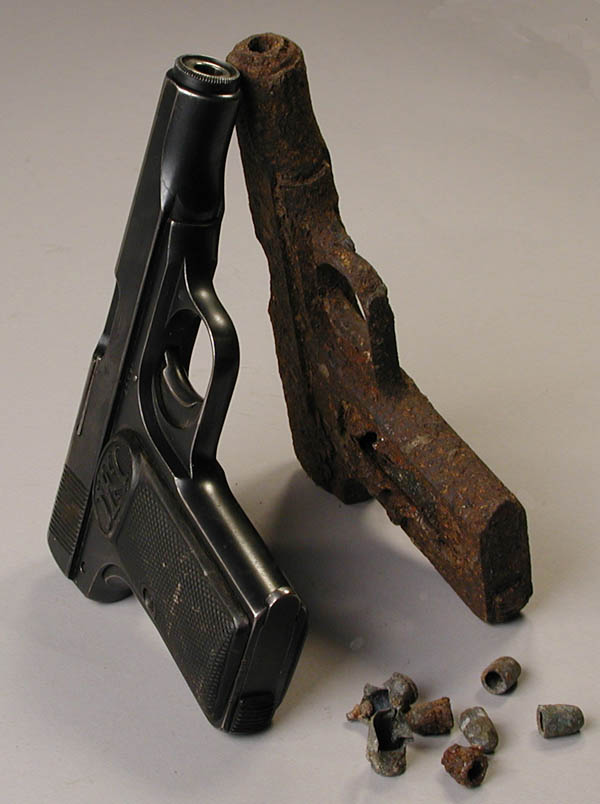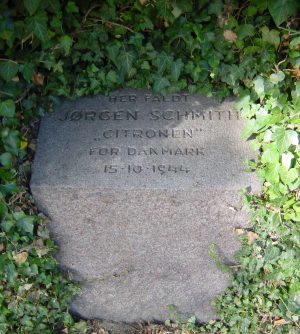|
Index
Intro
S.O.E.
Mk.I .32ACP
Mk.II&IIA .32ACP
The Suppressor
Mk.I 9mm Para
Production
Distribution
The U.S. Welrod
The Sleeve Gun
Misinformation
|
IN MEMORY

Jørgen Haagen Schmith
"The Lemon"
18.12.1910 - 15.10.1944
The Lemon.
One of the greatest and best-known members of the Danish Resistance movement, one half of the duo known as "The Torch" and "The Lemon", fell alone in a violent and heroic gun battle against the German occupational forces. With his death, yet another legend was born. Jørgen Haagen Schmith aka "The Lemon" ¹) went over in history in the same honourable manner as Col.. Svend Bartholin Paludan-Møller. That "The Torch" was to follow him only a few days later under similar circumstances was a terrible blow to the Resistance.
¹). "The Lemon" (Citron in Danish) was so named due to his work at a Citroen car repair shop.
Gunnar Dyrberg: I saw before me a dark-haired, well-built man of middle height. As he held out his hand and introduced himself, I looked at him curiously. He had a pleasant face, with kind brown eyes, and his smile was warm and friendly. He didn't look at all as I had expected. "The Lemon" was said to be fantastically daring, extremely fast in his reactions, and completely merciless when it was a matter og carrying out a dangerous mission. I shouldn't have dreamed that this man possessed such qualities. He looked like any ordinary family man of thirty-four, with no thoughts on his mind but keeping his job and looking after the wife and kids. I should have passed him in the street without a second glance. No one could have believed that he was one of the two most wanted men on the Gestapo's black-list. The other was his friend, "The Torch".
The Arrest.
September 19, 1944. Disguised as a police officer and driving in a stolen Opel Captain police car, "The Lemon" and Helmer Bomhoff is coming down Northern Alley of central Copenhagen. They are heading towards St. Hans Square when outside St. Johns church they are stopped by a German road block and subsequently arrested. Unfortunately on this day, the Germans have decided to remove from office and detain the Danish police force.
As he is already wanted and the stolen car contains his briefcase with two pistols and several hand grenades he realises that he must try to escape, as he can never pass a visitation. After approximately half an hour he, Helmer and a C.B police officer are taken into a nearby schoolyard for visitation and questioning. He whispers to Helmer that in a moment when he himself will attempt to escape, Helmer is to stroll out of the yard as if nothing had happened.
The Escape.
A few moments later he seizes an opportunity to attempt the impossible. A couple of garbage cans are standing against the wall enclosing the yard. He jumps onto the cans but as he is scaling the wall a man of the Schalburg Corps ¹), shoots him in the back perforating a lung. Badly wounded "The Lemon" falls to the ground. By coincidence the entire episode is being watched by a man working for Falck Rescue (Paramedic), and who has connections within the Resistance. He recognises "The Lemon" and hurries to call his station from a nearby phone booth. The station immediately dispatches an ambulance to the school. When the ambulance arrives, the Germans pull it over believing that it just happens to be passing by.
¹). The Schalburg Corps consisted of Danes collaborating with the German occupational forces.
In the ensuing chaos of "The Lemons" escape attempt, Helmer and the C.B police officer manages to leave the schoolyard unnoticed. In addition, the Germans forget to search "The Lemon" before placing him in the ambulance that will take him to Nyelands Street Infirmary. With him in the ambulance is a man from the Schalburg Corps. The Schalburg man is sitting in the back of the ambulance with his back to the driver whereas "The Lemon" lies with his feet towards the cabin.
To his surprise "The Lemon" recognises the driver as a member of the Resistance, immediately regaining hope that he can yet escape. His plan hinges on getting the two Falck paramedics out of the car, why he fakes being near death with thirst and dehydration. The Schalburg man orders the driver to stop at a pharmacy and sends both the paramedics away to fetch water. The instant the paramedics are out of the car "The Lemon" draws his .25 ACP hidden in his boot and kills the Schalburg man with three shots to the head. He is then taken to Falck headquarters and from here to Frederiksberg Hospital where he receives proper medical attention. The dead Schalburg man was taken to the infirmary on Nyelands Street and the paramedics explains that the patient suddenly had pulled out a gun and killed the guard continuing his escape on foot!
The Safe House.
At the hospital only a few hundred yards away "The Lemon" was given blood transfusion and an examination determined that the bullet had entered under his right shoulder, perforated his left lung and exited at his left armpit. For fear that the Germans would search for him at the hospital, he was then transported in an ambulance to a safe house at 184, Jaegersborg Alley, owned by Cand.Pol Aage Stroem-Tejsen, where a nurse from the Resistance named Ellen Christensen would care for him.
October 14, 1944, "The Lemon" had recovered enough that he could walk around inside the house. The next day he was to be taken to another safehouse at Sejroe Bay where he could regain his strength. Unfortunately as misfortune would have it, this very night Gestapo came to arrest the owner of the house, who was not at home. "The Lemon" heard German voices outside the door, and the words "Deutche Sicherheit Polizei" (German Secret Service) convinced him that they had come for him. Two Germans entered the house and one of them approached the bedroom on the first floor he was in. Realising that he was still too weak to attempt an escape, "The Lemon" responded by shooting through the door, wounding the German in the shoulder.
The Shoot Out.
One of the Germans called for backup and two more Gestapos came running into the house with their guns drawn. They tried to get through the hall and to the bedroom from where "The Lemon" had not moved, when a detonation shook the house. "The Lemon" had thrown one of his grenades. He now barricaded himself in the adjacent dressing room giving way unto the entrance, from where he was able to cover the hall, the corridor and the bedroom. Gestapo fired blindly into the darkness, but nothing could be heard now apart from the faint crackle of the furniture that had caught fire.
The Germans were shouting trying to be heard above each other, questioning the nurse as to how many people were in the house, convinced as they were that there must be Resistance agents on both floors and in the basement. From the dressing room not a sound was heard. The Germans led the nurse outside the house onto the stairs. Standing there she asked in a loud voice if they really meant for her to be left out there on the stairs. It was her hope that "The Lemon" would hear this and understand that he now had unrestricted field of fire. He must have heard, for only seconds later a long burst from a submachine gun riddled the door with holes and one of the Germans slumped to the floor with a rattling sound. Gestapo immediately returned fire through all the doors. In the commotion the nurse managed to escape her guardians and run through the garden to hide in a bush. From her hiding place she saw three Germans running from the house bent over and wounded, closely followed by a grenade thrown from the house. The grenade detonated in the garden behind them. The nurse continued to run to a house a few hundred yards away where she was given money and a coat so she could get on her way to Copenhagen. From this distance from the house she could clearly see the fire and hear the noise of automatic weapons and detonating grenades.
By now reinforcement of 200 German soldiers from the nearby Jaegersborg Barracks, had arrived to surround the house. The ensuing fire fight lasted for more than three hours. Witnesses have described how "The Lemon" limping from room to room returned fire with everything in his possession including several grenades.
After a while the fire was burning uncontrollably and the house was enveloped in blazing flames, forcing "The Lemon" to come out. Neighbours tell how he, wearing a blood-soaked blue-and-white striped pyjama and as fast as his injuries would permit, tore out through the front door shooting his STENgun, only to collapse moments later on the front lawn, cut down by several bullets through the chest.
The Aftermatch.
Yet a brave Danish member of the Resistance had fallen under the German yoke, taking with him eight Germans and wounding another four. "The Lemon" had often said that he would never be taken alive and as always he remained true to his word. He went out as he would have wished - fighting to the last. He left behind his pregnant wife and a three-year old daughter.
As always when the Germans found a hideout of the Resistance, the place would be blown up with everything it contained. In this case however, the fire left nothing of the house to be blown up, even the walls had collapsed. The house was later restored and during an excavation of the garden in 1982, an FN Browning pistol Model 1910 .32 ACP, was found. The pistol is presumed to have been one of the many weapons in "The Lemon's" arsenal that day, but it could also have been from one of the fallen Germans. By coincidence "The Torch" who was on an operation in Jutland on the 14.th of October, had left a suitcase containing all his personal weapons with -The Lemon" before leaving. For this reason "The Lemon" was more than well equipped on that fateful day. The suitcase contained among other; 2 STENguns, a Luger P08, and a pistol .25 ACP plus a cluster of hand grenades and ammunitions and it all came into good use.
 This is the FN Model 1910 that was found during excavation of the garden shown against one in perfect condition. Due to the extreme temperatures in the fire the ammunition in the magazine has exploded, tearing a hole in one side of the magazine. Below the pistols are seen two exploded shell casings and five projectile jackets with its lead core melted away. The pistol is kept at The Museum of Danish Resistance 1940 - 1945, in Copenhagen.
.
This is the FN Model 1910 that was found during excavation of the garden shown against one in perfect condition. Due to the extreme temperatures in the fire the ammunition in the magazine has exploded, tearing a hole in one side of the magazine. Below the pistols are seen two exploded shell casings and five projectile jackets with its lead core melted away. The pistol is kept at The Museum of Danish Resistance 1940 - 1945, in Copenhagen.
.


The memorial stone erected at the address 184, Jaegersborg Street, Gentofte.
Sources:
Berlingske Tidende 20. oktober 1944.(Danish Newspaper)
The Giant-Killers - John Oram Thomas. ISBN: 0-7181-1340-3
Faldne i Danmarks frihedskamp 1940 - 45. ISBN: 87-88214-265
Bogen om Jørgen, "Citronen". - Bent Demer.
Unpublished Sources:
Story by Elisabeth Bomhoff. (The Museum of Danish Resistance 1996)
Obituary for "Citronen". (The Museum of Danish Resistance 1940 - 1945, anonymous)
Written by Anders Thygesen.
|
